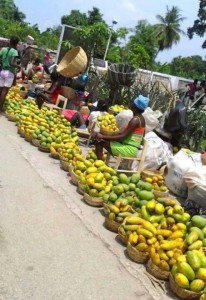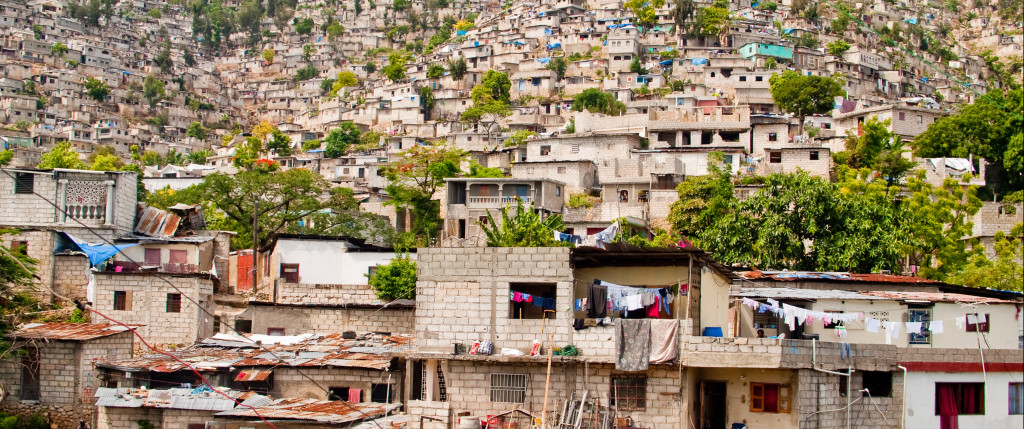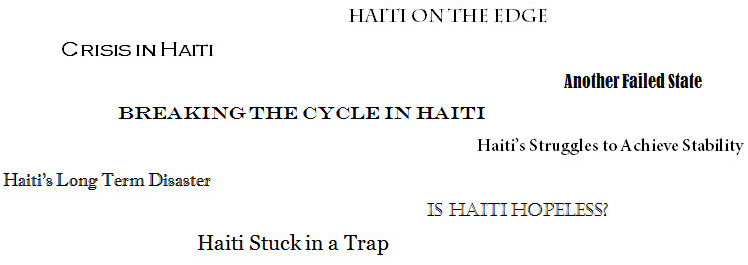Continued from Part 1…
Haiti, and more specifically the capital of Port-au-Prince, is a place where blan, as well as milat (mulattos) are rarely seen walking the streets or taking public transportation, especially by themselves. The reason – as most anthropologists would say – is complicated. Many cite the threat of violence as reason enough to cling to private vehicles and gated buildings. Whether or not the country’s stigma of violence and instability aligns with an objective reality, the image and discourse of danger remains and has a pervasive influence on how foreigners – and Haitians themselves – understand the country. The media plays a prominent role in perpetuating the idea of a permanent state of crisis:
“Aren’t you afraid of being raped?” – inquired the arrogant young doctor seated next to me on the plane. We were just leaving Detroit and heading towards Fort Lauderdale: a stop-over for me, a stopping point for him. I had just informed him of my destination and my previous experiences in Haiti – walking the streets by myself, taking public transportation. Would my objections and personal experiences make a dent in his belief about the violent nature of Haitians? Probably not. He already knew all about the Haitian mentality – as a doctor in Florida, he treated Haitians every day. He had his own ideas of what Haiti was like – even despite never having been there.
Even as foreigners carry an abundance of stereotypes about Haiti, the assumptions Haitian residents of Port-au-Prince had of me, as a blan, were made clear right off the plane. Aided by friends I had met the previous summer, the shock of arriving alone in a foreign country was mediated. I had maintained regular email contact with Jean and he generously arranged housing and private transportation from the airport that summer, convincing Wilson, another student, to help by meeting me at the airport. Once securely packed away in the vehicle, Jean, Wilson, our driver, and I took off to what was to be my home for the summer. Mental exhaustion overtook my already poor ability to communicate in the local language, Haitian Kreyòl. In the car, they debated what I would eat and how I would live. Contributing to this discussion would probably have been helpful, but my mind refused to cooperate. Instead, I smiled and nodded.
The trip took longer than it should have since it started raining heavily and the truck overheated. As we waited at a gas station for the driver to get the truck running again, we chatted about how Port-au-Prince residents are generally afraid of the rain. Crowds of people huddled under the same awning as us, seeking shelter from the downpour. It seemed silly to me at the time. It’s just a little rain, I thought. I hadn’t yet experienced the speed at which streets could become raging torrents. I hadn’t yet realized the difficulty of finding a spot on a tap-tap (public transportation) once the rain had started.
Watching the traffic go by, Jean pointed to one of the many crowded tap-taps braving the heavy rains and, with a chuckle and a grin, asked me if I could imagine having to take them everywhere I needed to go. With colorfully painted slogans, such as “Bondieu c’est tout” (God is everything), the tap-tap he pointed to was one of many pick-up trucks outfitted with wagon-like coverings built over two long benches inside the truck bed. Later I would learn that, most of the time, they’re full to the brim. It’s often surprising how many people can (and do) squeeze into the available seats. At particularly busy times of the day, people can be seen hanging off the back or standing hunched inside, waiting for the next person to get off so they could squeeze onto the bench, requesting others to avanse or scoot down just a little bit more, just a little bit further. In that moment, mentally exhausted and linguistically challenged, I didn’t know how to respond to Jean’s – rhetorical? – question. I was confused. Why was he making the assumption that I wouldn’t be relying on tap-taps? Silently, I wondered, how else I was going to get around?
What was lost in cultural translation was why a blan (a female one at that) would choose to live like an ordinary Haitian by relying on local transportation. From one vantage point my daily choices were very much stereotypical insofar as I was acting as a “typical” anthropologist would. I was determined to live life as an “ordinary” Haitian would and not rely on such luxuries as a private vehicle, hotel-like accommodations, or expensive restaurants. From another vantage point, however, I was a fake. I was the anti-stereotype, defying the typical image of a blan in my willingness to walk the streets, eat street food, and travel by public transportation. I had to work aggressively against this stereotype as my friends and guides initially made a number of assumptions about my tolerance levels regarding daily living choices.
But, perhaps Jean had been partially right. It took me a few solid weeks to really get used to the idea of relying on the tap-tap system. It wasn’t their normally over-crowded state or the inconvenience of waiting for one that wasn’t chàje, or full to the brim. Rather, it was my stubborn desire to feel in control of the situation – or, at least to give the appearance that I understood what was going on or where I was going. I quickly learned to swallow my pride when it came to linguistic roadblocks, but I had a far more difficult time putting myself in situations that might signal to others that I didn’t know what I was doing or where I was going. I felt this way despite the reassurances I received that all I had to do was ask and most people would be happy to help with directions. Instead of swallowing my pride and asking for help, I walked. A lot.
I enjoyed the independence of walking. In retrospect, however, I can see how masochistic I was in my stubborn refusal to take the extra tap-tap from the house where I was staying to the main thoroughfare. Regardless, my walking served an important purpose: It habituated me to my surroundings. I was able to make observations that would otherwise be impossible seated inside a tap-tap. It also habituated other people to my presence. Walking with an air of deliberateness, I navigated the (sometimes) precariously narrow and uneven spaces along the sides of the road. The weaving movements – between people, cars, along curbs, and past vendors – felt choreographed; my body took over in leading me through the ballet of street navigation. My movements became habituated and automatic. Holding my breath as I walked through frequent puffs of dust, I could feel the sun’s heat beating down on me, threatening to exhaust me as it so often did. But I always trudged along anyway, no matter what time of day I happened to be out, armed with layers of sunscreen, a light shirt and maybe a hat.
The heat didn’t bother me that much, although most people didn’t appear to understand this. “Al-i-sòn!” – Carline would scold – “Chalè a fò jodi a!” (It’s hot today!). While I understood the desire to hide away in the shade during the hottest times of the day (probably a wise idea, really), I longed to be out and about. And so, I quickly got used to the constant layer of sweat, dirt, and sunscreen coating my body. Sweat soaked my clothing whenever something pressed it against my skin – my purse strap never failed to leave a sweat-laden imprint on my back and chest.
My daily trek along Delmas 75 – a major thoroughfare – included navigation across a narrow bridge-like passage, a popular site for tossing garbage, despite a prominent sign proclaiming “Pa jete fatra!” (Don’t thrown garbage!). From there, I climbed a steep hill, walking steadily along the curb, maintaining a constant speed. I would pass by a multitude of street vendors – selling everything from phone cards to cooked food, household goods, snacks and beverages, used clothing, alcohol and cigarettes. The smell of food filled the air, mixing with less pleasant aromas like exhaust fumes and urine. While snack foods such as toasted corn cobs or fried plantains appeared to be more visibly available – with vendors perched on street curbs – more substantial meals made up of rice, bean sauce, BBQ chicken, or spaghetti were also available at select times of the day. Learning the secrets of where things were located, where I could find what I was looking for (or what I didn’t know I wanted) was something that both frustrated and amused me. I was jealous at the ease with which locals navigated the informal market, the neighborhood scene. Local residents knew just where to go, without the need for signs pointing them to houses that doubled as restaurants at various times of the day.
The deluge of informal vendors that dominate the streets (and homes) of Port-au-Prince is not simply a continuation of a more “traditional” economic system, as one might assume. Referencing Andean market women, Weismantel reminds us that “neither the market nor the food for sale there represent precapitalist economic relations… These markets, which today are overrun by more would-be sellers than customers, are less remnants of a vanishing precapitalist past than indicators of the instability caused by the neoliberal present”.1 While I recognized the informal market as a response to a lack of formal employment, I still caught myself romanticizing the interpersonal relations built into the direct buyer-seller interactions that dominated the streets. I was struck by how much more personal and human the experience of buying seemed – it was more real to me than the impersonal and sometimes cold interactions that often accompanied a trip to the supermarket, in Haiti or the U.S.
But even as I idealized the intimate buyer-seller relationships, actually buying items from street vendors was an uncomfortable task for me. While I gained confidence in my ability to haggle prices, I still lacked the quick witted back and forth that so often accompanies many street level exchanges: The feigned insult at the initially cited price, the counter offer (and counter feigned insult), the back and forth until an agreed upon price is nearly found, and the final display of control by customers in the form of looking for any potential defect in an effort to either push for an additional item (yon lòt) or demand a different one. In these exchanges, I couldn’t ignore the reality of my blan-ness. Unless I knew the “regular” price, I could never be sure if the price cited initially included what I came to think of as “the blan tax” or not.
“Konbyen pou senk mango?” (How much for 5 mangos?), I inquired of the lady seated in the back of a colorful tap-tap full of yellow and green mangos, a load she would surely rid herself of by the end of the day. “Di dola,” (10 dollars), she responded after eyeing me briefly.
Processing prices was by far one of the most difficult tasks for me. My delay in responding to the vendor only increased the appearance of my ineptitude at haggling properly; or at least, that’s how I imagined I appeared. Compounding the problem further was a dual system of prices: There are gourdes – which is the official currency – and then there are “Haitian dollars,” which don’t technically exist. In the minds of Haitians, however, the Haitian dollar most certainly does exist. In fact, I encountered many Haitians who would mentally process an item’s value in Haitian dollars and, as I found, actually had difficulty making the calculation back to gourdes. Armed with bills and coins valued in gourdes, the calculation appeared to me like a necessary step. It’s not uncommon for there to be confusion between Haitians and blan – as prices are thrown around in dola (dollars). It can be easy to forget the Haitian dollar system and assume the price being cited is in American dollars, another valid currency at some established businesses. This confusion can and does get taken advantage of.
In that interaction, with the mango vendor, it was clear that the price had been elevated because of my blan-ness. Since it was mango season, I already knew the “regular” price was 25 gourds for 5 mangoes (5 “dollars” instead of the 10 she cited). I could have haggled, but I feared a weak performance. A customer who had just completed his own purchase exclaimed, indirectly haggling for me, “Se pa vre!” (That’s not true!). But it was too late. I had tried too hard to remain in control, tried too hard not to look like a clueless tourist. Instead of trying to talk her down, I was already walking away.
If my visibility on the street level set me apart from other blan in the country, then my eagerness to walk and my hesitation in making purchases on the street, pushed me further away from what was considered normal behavior for most Haitians. I was teased about my walking by the people in my house. From what I could gather, they were confused as to why I would choose to walk instead of monte machin (take public transportation). Fritz, a young man of 26 or 27 years, would regularly comment on this. Fritz was a comedian. He lived and worked near the house where I was staying and regularly stopped by to chat and joke with anyone willing to engage him. He enjoyed abusing the fact that I was unable to grasp what he was saying most of the time – his use of obscure expressions, double entendres, and rapid-fire jokes often left me in the dark linguistically. And he knew it: “Se pa bagay ou ta konprann” (It’s not something you would understand), he would quickly throw at me before returning to the mimicked impression or joke he was telling us. These little interludes – his efforts to make me a part of his performance – were jokes inside jokes, inciting laughter from the group. I was asked, at one point, if I ever got angry.
Of course, I found it frustrating to always be the butt of a joke, but I also used those moments to concentrate on improving my comprehension skills. The day I can fully understand Fritz, I thought, will be the day I can say I’ve mastered the language. On one rare occasion when we spoke directly to one another, when he took the time to speak slower and repeat himself, he inquired as to why he never saw me monte machin. My response seemed hollow to him and he remained unconvinced that I merely enjoyed walking. Two months into my stay, he was still making jokes about my walking habits: “Al-i-sòn pa monte machine” – he sang to Carline after I returned to the house one day, exhausted from the heat and the sun. “Oh-Oh!” – I responded using a common Haitian expression of surprise – “Ou kwè m mache tout kote? Pa posib!” (You think I walk everywhere? Not possible!). I may not have mastered the language yet, but in that moment, I did succeed in returning the banter; for this I received a surprised look from Fritz and laughter from those around us.
1 Mary Weismantel, “Cholas and pishtacos: Stories of race and sex in the Andes” (2001), pgs 143-144.↩


